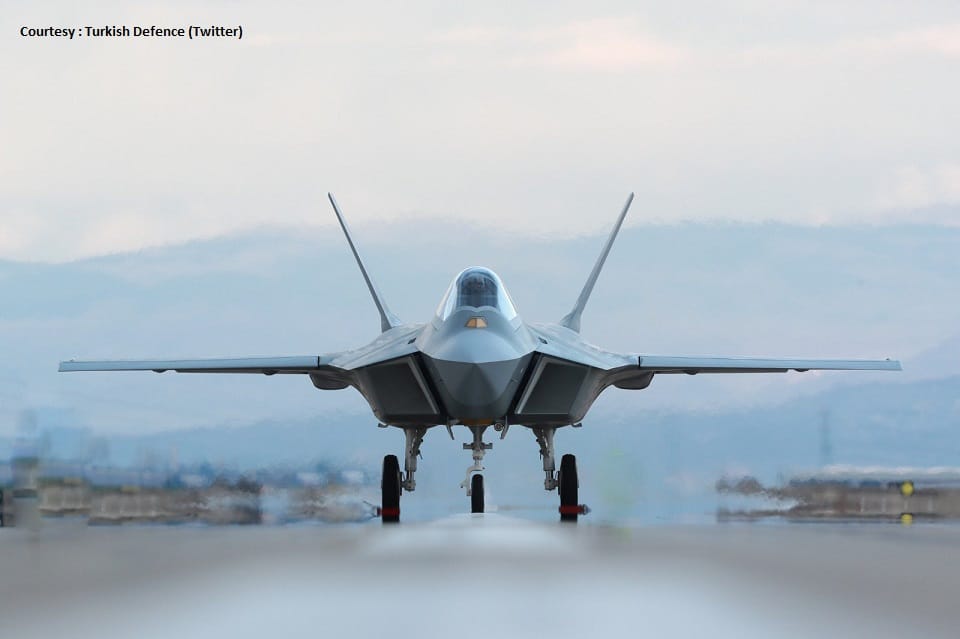Aviation
5 things to know about Turkey’s brand-new 5th generation fighter jet ‘KAAN’

After China, the United States, and Russia, Turkey is now the fourth nation in the world to own its own indigenously constructed fifth-generation fighter aircraft. It has now demonstrated the ability to construct sophisticated aircraft on its own.
- Turkish fifth-generation fighters to replace F16s.
Next-generation air superiority fighter being developed by Turkey is the Turkish 5th Generation Fighter Aircraft (TF-X). The Turkish Undersecretariat for Defence Industries (SSM) launched the program in 2016 with the goal of developing a homegrown fighter to replace the Turkish Air Force’s deteriorating F-16 fleet. The project’s goal is to create a locally made fighter jet to replace Turkey’s ailing F-16 fleet, which was built in the United States and has been in use since the 1980s.
Turkish Aerospace Industries (TAI) and BAE Systems, a British multinational defense business, are working together to build the TF-X. The aircraft is anticipated to include cutting-edge sensor and weapon systems, superior avionics, and stealth capabilities. Additionally, it is anticipated to have a range of more than 2,000 km and a top speed of Mach 2.
2. This aircraft’s powerplant is a Rolls-Royce EJ200 engine
Due to geopolitical concerns, GE initially expressed no interest in developing an engine for the Turkish 5th-generation fighter. Further, Rolls-Royce proposed technology transfer for the EJ200 engine and joint development of a derivative for the TF-X program after the BAE System agreed to the development of an aircraft. Even Russian Unite aircraft companies have expressed interest in producing engines for this craft. Turkey, however, continues to use Rolls Royce from the UK.
With the production of this aircraft, Turkey joins a select group of nations that have the facilities and know-how to build fifth-generation combat aircraft. The twin engines of the 21-meter jet, each of which is capable of producing 29,000 pounds (13,000 kilograms) of thrust, enable the aircraft to travel at a top speed of 1.8 Mach.
3. It has featured with latest avionics configurations.
A number of cutting-edge technologies are anticipated to be incorporated into the TF-X, including a next-generation active electronically scanned array (AESA) radar system, sophisticated communications systems, and superior electronic warfare capabilities. Advanced stealth characteristics for the aircraft are also anticipated, including as radar-absorbing materials and cutting-edge coatings to lower its radar cross-section.
4. The maximum flight speed of the KAAN fighter jet is 2716 km/hr.
The single- and double-seat KAAN fighter jet is 21 meters long, has a 14-meter wingspan, and is 6 meters tall. This aircraft’s maximum takeoff weight is approximately 27,215 kg, and its two GE F110 engines have a combined thrust capacity of 76.31 kilonewtons and an afterburner thrust capacity of 131 kilonewtons. The aircraft’s top speed is 2,716 km/h, and its combat range is up to 1,100 km.
5. Can carry a variety of advanced weapons.
It is capable of carrying a range of armaments in the internal bay area, including air-to-air missiles made in Turkey, such as the Goktug, MBDA, and other BVR missiles, and air-to-surface missiles, such as the SOM cruise, Kuzgun family of missiles, Turbojet, Solid fuel rocket, and MBDA Spear 3.
It is also capable of transporting several bombs, including the Teber 81, HGK, KGK, and SARB weaponry.
This aircraft would be an excellent value for possible customers from Pakistan, Malaysia, Indonesia, and other Asian nations since it will serve as a substitute for the US-built F35 and Russian Sukoi 57 aircraft. If they concentrate on mass-producing aircraft in Turkey and have stronger control over engine manufacture independent of other industries, the cost will be decreased.

Aviation
Boeing, Antonov to Collaborate on Defense Projects

– MOU represents Boeing’s commitment to work with Ukrainian industry
– Includes exploring opportunities for collaborating on in-country support of Unmanned Aerial Systems
A Memorandum of Understanding was signed today by Boeing and Antonov Company to investigate potential collaboration on defense-related projects.
“We’re happy to keep collaborating with the Antonov Company to help Ukraine’s economic development and expansion,” stated Ted Colbert, CEO and president of Boeing Defence, Space, & Security.
Airbus and the Antonov An-225: The Best Partnership:Click here
“This agreement demonstrates our ongoing efforts to find more opportunities to work with Ukrainian industry, which was underscored by our signing of the Ukrainian Defence Industry Compact earlier this year.”
The areas of potential collaboration identified in the agreement consist of training, logistical support and overhaul services for tactical Unmanned Aerial Systems utilized by the Ukrainian Armed Forces, which includes the ScanEagle. In addition, the companies will also explore opportunities for Antonov to provide engineering support to Boeing.
The six largest cargo aircraft ever built in the aviation industry:Click here
“A strong, innovative, and efficient defense industry is key to sustainable economic development and national security, and we are extremely excited to collaborate with Boeing,” said Ievhen Gavrylov, CEO of Antonov Company.
This agreement brings a whole new level of opportunity to implement the latest and most effective solutions – in addition to the possibility of future projects with Boeing in the aerospace and defense industry.”
-

 Travel1 week ago
Travel1 week agoAir India to Expand US Operations with Three New Routes After a Decade
-

 Travel2 weeks ago
Travel2 weeks agoWhy We Should Avoid These Stamps in a Passport
-

 Airlines1 month ago
Airlines1 month agoInvestigations Reveal Fake Chinese Titanium in Boeing and Airbus Jets
-

 Tech4 weeks ago
Tech4 weeks agoChina’s CATL Plans 1,800-Mile Electric Plane Launch by 2027
-

 Airport3 days ago
Airport3 days agoTop 10 Largest Airports in the World by Size
-

 Aerospace4 weeks ago
Aerospace4 weeks agoChina’s Fighter Jets Turn Wings into Autonomous Drones
-

 Airlines4 days ago
Airlines4 days agoAir India Rolls Out A350s for Delhi-New York JFK and Newark Routes
-

 Defence3 weeks ago
Defence3 weeks agoBoeing Enhances Chinook with New Engines and Block II Upgrades at $96 Million







